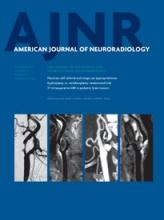Abstract
BACKGROUND AND PURPOSE: CT-guided biopsy is the most commonly used method to obtain tissue for diagnosis in suspected cases of malignancy involving the spine. The purpose of this study was to demonstrate that a low-dose CT-guided spine biopsy protocol is as effective in tissue sampling as a regular-dose protocol, without adversely affecting procedural time or complication rates.
MATERIALS AND METHODS: We retrospectively reviewed all patients who underwent CT-guided spine procedures at our institution between May 2010 and October 2013. Biopsy duration, total number of scans, total volume CT dose index, total dose-length product, and diagnostic tissue yield of low-dose and regular-dose groups were compared.
RESULTS: Sixty-four patients were included, of whom 31 underwent low-dose and 33 regular-dose spine biopsies. There was a statistically significant difference in total volume CT dose index and total dose-length product between the low-dose and regular-dose groups (P < .0001). There was no significant difference in the total number of scans obtained (P = .3385), duration of procedure (P = .149), or diagnostic tissue yield (P = .6017).
CONCLUSIONS: Use of a low-dose CT-guided spine biopsy protocol is a practical alternative to regular-dose approaches, maintaining overall quality and efficiency at reduced ionizing radiation dose.
ABBREVIATIONS:
- CTDIvol
- volume CT dose index
- DLP
- dose-length product
- kVp
- peak kilovoltage
- mGy
- milligray
- © 2014 by American Journal of Neuroradiology












